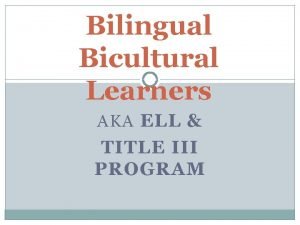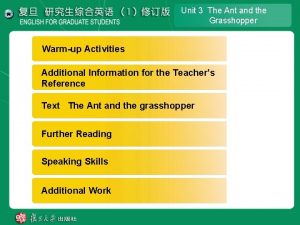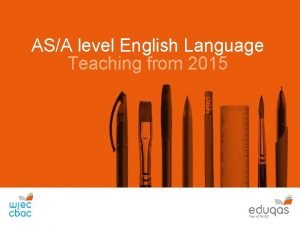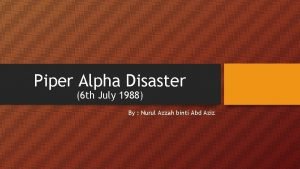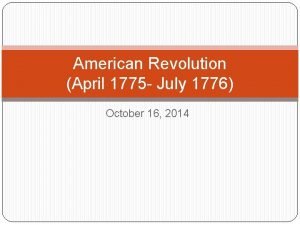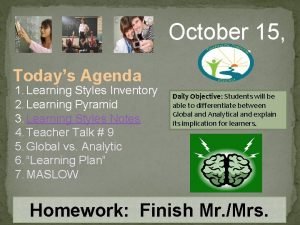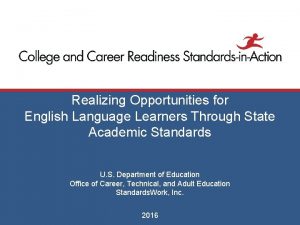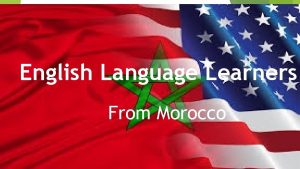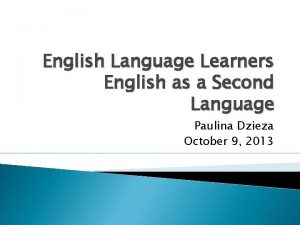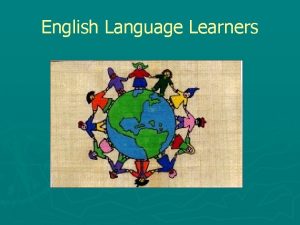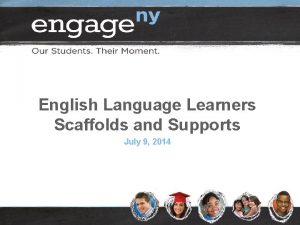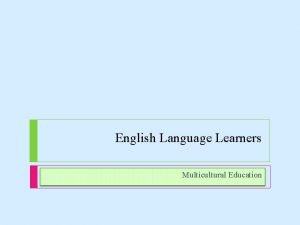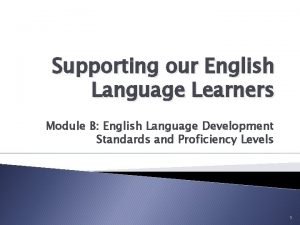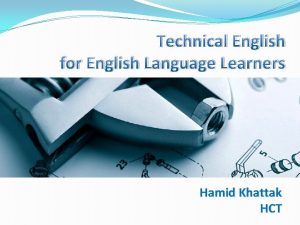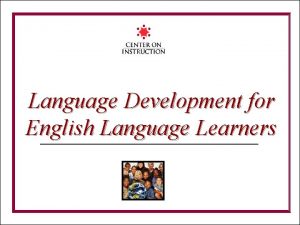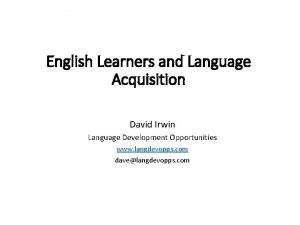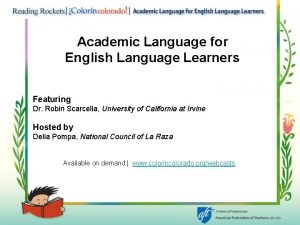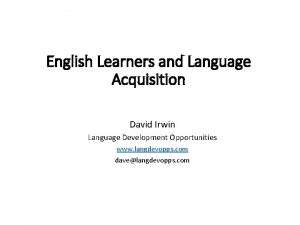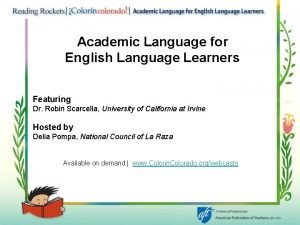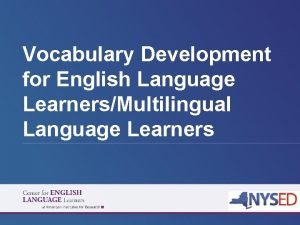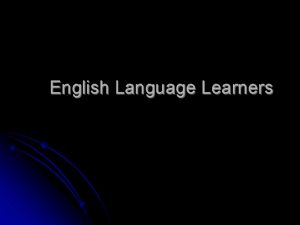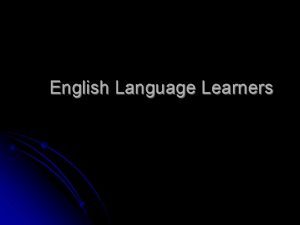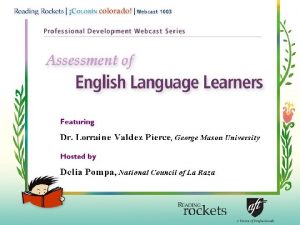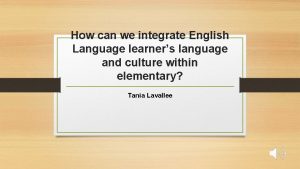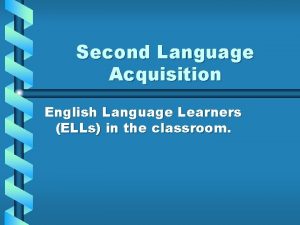Realizing Opportunities for English Language Learners July 2016

![In the Words of Lily Wong Fillmore. . . English language learners [ELL] are In the Words of Lily Wong Fillmore. . . English language learners [ELL] are](https://slidetodoc.com/presentation_image/5159679e0a9324956acd3bdfa59a8fa4/image-2.jpg)





































- Slides: 39

Realizing Opportunities for English Language Learners July 2016
![In the Words of Lily Wong Fillmore English language learners ELL are In the Words of Lily Wong Fillmore. . . English language learners [ELL] are](https://slidetodoc.com/presentation_image/5159679e0a9324956acd3bdfa59a8fa4/image-2.jpg)
In the Words of Lily Wong Fillmore. . . English language learners [ELL] are provided materials that are so greatly simplified that they provide virtually no exposure to the forms and structures of the language they should be learning … [There’s] a lot of attention and energy focused on turning ELLs into English speakers, and not nearly enough on educating them. What ELLs need are authentic and age-appropriate texts … with appropriate instructional support from teachers who know how to support language development. – Lily Wong Fillmore, September 2010 PAGE 2

Demographic Imperatives • English language learners (ELLs) comprise around 25% of the total US public school population. • Many state are experiencing exponential increases in ELL populations. PAGE 3

Top 12 States With the Fastest Growing ELL Enrollment (1998 -2008) Source: Council of Great City Schools PAGE 4

Top 25 Districts by ELL Enrollment (2011 -2012) Source: Council of Great City Schools PAGE 5

ELLs Bring Many Resources to Learning! • Knowing another language in our global economy is a good thing. . . a very good thing! • Many ELLs have first language and literacy knowledge and skills that boost their acquisition of English and learning more broadly: o ELLs who are literate in a first language that shares cognates with English can apply that knowledge to second language acquisition. o ELLs often have a heightened awareness of grammatical functions and effects because they are using two or more languages. o ELLs can bring conceptual knowledge they developed in their first language to their disciplinary studies. PAGE 6

Counter-Productive Instructional Practices: • Practice #1: Makes learning English a bridge ELLs must first cross before they are allowed to study fields of genuine interest to them, such as science, history, etc. • Practice #2: Left without access to the rich texts of academic disciplines, ELLs are often provided with “mush” to read. PAGE 7

Why Have They Endured? • Often based on the assumption that ELLs will be put off— frustrated—by anything that is too hard. • And based on the assumption that adapted, decodable texts allow ELLs to read and access meaning on their own. But, what is forgotten is that. . . • Simplified texts don’t offer students the complex syntax, vocabulary, or the concepts they need to learn and succeed. • Academic language can only be learned by noticing how it works in authentic texts—engaging with, thinking about, discussing and writing about their content. PAGE 8

ELL Expert Contributions to the Common Core • Asked us to strengthen the global and cultural diversity of the reading selections. • Added standards that require students to adapt their writing and speaking to a variety of contexts and communicative tasks. • Added aspects of comprehension monitoring, e. g. , ability to request clarification, confirm comprehension, ask questions. • Spoke forcefully in favor of literacy across the disciplines and helped to sustain their inclusion. • Insisted grammar and usage be acquired in the service of communication and comprehension. PAGE 9

New Standards—New Imperatives • ELLs learn language best when they engage with content. • With support, ELLs must participate in classroom discourse focused on rich and exciting academic content. • The only way ELLs can gain the complex language skills needed for doing anything in school—in life— is by working with complex demanding reading materials. • To meet the new standards, instruction must immerse ELLs in meaning-making language and literacy activities. • Instruction needs to capitalize on ELLs’ existing talents (L 1, background knowledge, interests and motivations). PAGE 10

Bottom Lines • Much more time and attention needs to be on educating ELLs, not just focused on turning ELLs into English speakers. • Academic language is context dependent—it depends on what is being communicated, how it is used, by and for whom, and for what purpose. And that means… ELLs can no longer be considered the sole responsibility of a small cadre of language specialists. . . preparing ELLs must become a shared responsibility with content teachers! PAGE 11

Relationship Between Language and Meaning or Content Language: We need to learn thousands of words. The words themselves often have multiple meanings and complex relationships to each other. Meaning or Content: We have to put these words together in phrases, sentences, charts and diagrams to construct meaning. From words, we build explanations, narratives, discussions, and arguments. Language is an essential tool for connecting different pieces of what we know. PAGE 12

Old Paradigm Content Mostly vocabulary, Grammar Source: Understanding Language Project Language PAGE 13

New Paradigm Source: Understanding Language Project Content Discourse Text (complex text) Explanation Argumentation Author Purpose Text Structures Sentence Structures Vocabulary Grammar Language PAGE 14

Let’s watch a Grade 8 video of an ELA classroom. . . PAGE 15

Reading: Engage with Complex Texts to Build Knowledge • Standards Require ELLs to read and comprehend literature and informational texts of increasing complexity. • Standards Challenge ELLs to process intricate and complicated linguistic and cultural features accurately while trying to comprehend content. PAGE 16

Research tells us that opportunities for reading development can be realized by. . . • Choosing complex, authentic texts that: ü Are brief, interesting, and engaging for students. * ü Emphasize one or two complexity features at a time (e. g. , a lexically dense piece with a simpler grammatical structure). ü Connect to a given unit of study and build the students’ knowledge of a topic. * ü Provide sufficient detail and examples for students to be able to comprehend the passage. * ü Contain ideas that can be discussed from a variety of perspectives. * PAGE 17

Research tells us that opportunities for reading development can be realized by. . . • Reading the text aloud at the start of the lesson, and then facilitating a discussion about the words in the text. * • Concentrating on a small set of academic vocabulary in a given text for in-depth instruction over the course of several lessons. • Building on and expanding ELLs knowledge about how different kinds of texts are structured. * • Providing necessary contextual information and leverage ELLs’ background knowledge without paraphrasing or “preempting” the text for students. PAGE 18

Opportunities for reading development can be realized by, continued • Offering readers more accessible texts (including those in a students’ L 1) in preparation for reading more difficult texts on the topic. • Simplifying wording of questions (e. g. , What does the author tell us about how this historical event affects Mexico today? “…how Mexico changed because of the Aztec period? ”)* • Providing additional instruction in small groups consisting of three to five students who are struggling with language and literacy. * • Focusing readers’ attention on meaning-critical grammatical structures (and how those might compare with how grammar is used to make similar meaning in students’ first languages). PAGE 19

Writing: Use Evidence to Inform, Argue, and Analyze • Require ELLs to write different text types for varied audiences/purposes, analyze information, and present knowledge gained through research. • Challenge ELLs to use language skillfully to cite specific evidence when writing arguments and informational reports. PAGE 20

Research tells us opportunities for writing development can be realized by. . . • Giving ELLs meaningful ideas to write about rather than mechanical exercises. * • Providing writing opportunities that are anchored in content to extend student learning and understanding. * • Strategically using tools—visuals and graphic organizers—to anchor instruction and help students make sense of content. * • Using a set of instructional routines that support students as they generate and organize their ideas for writing and research (e. g. , discussion to notes to graphic organizers to paragraphs, and finally to compositions). * PAGE 21

Opportunities for writing development can be realized by… • Providing substantive feedback on the lesson’s instructional objective to ELLs about the content of their writing at multiple points throughout the writing process. • Providing ELLs with meaningful exposure to mentor texts to focus on language and text structure. • Allowing ELLs to use their home languages or varieties of language during the writing process, including working and talking in pairs. * • Attending to the fact that some writing skills are affected by students linguistic and cultural backgrounds that may not align with those in the standards. * PAGE 22

Writing & ELLs’ Cultural and Linguistic Backgrounds (Some Examples) • Typical Chinese style: praises eloquent language and avoids making direct points or arguments. • Typical Arabic style: does not tend to present different perspectives or counterarguments; does not challenge what is socially validated; and pays more attention to impressiveness than to logic and reasoning. • Typical Japanese style: is restrained, undemonstrative, cautious, and understated. Flashes of insight are valued without the intermediary steps of syllogistic reasoning. • Typical Finnish style: does not prepare the audience for what to expect and the conclusions. • The rules of ‘articles’ and ‘tenses’ do not exist in many languages. Sources: http: //www. colorincolorado. org/blog/culture-and-writing-ells-ccss-part-2; Influence of Cultural and Linguistic Backgrounds on the Writing of Arabic and Japanese Students of English Bouchra Moujtahid; www. ccsenet. org/elt PAGE 23

Speaking and Listening: Work Collaboratively and Present Ideas • Require ELLs to articulate their own & build upon other’s ideas and demonstrate understanding of informal interactions and formal presentations. • Challenge ELLs to employ a range of listening comprehension and speech production strategies. PAGE 24

Research tells us how opportunities for speaking and listening can be realized. . . • Developing meaningful collaborative tasks that allow ELLs to use their full linguistic and cultural resources. * • Providing ELLs with daily opportunities to talk about content in pairs or small groups, anchored around topics present in the text(s). * • Structuring student groups and provide guidance to facilitate focused and targeted discussions (e. g. , have students cite evidence from the text to support the position they take). * PAGE 25

Opportunities for speaking and listening can be realized by… • Allowing ELLs to collaborate in their home languages as they work on tasks to be completed in English. * • Including listening comprehension activities designed to help ELLs to arrive at a reasonable interpretation of extended discourse, rather than to process every word literally. * • Allowing ELLs to engage productively using language that is still under development and may exhibit “non-native” or imperfect features. * PAGE 26

Language: Use and Develop Linguistic Resources • Require students to choose language and conventions to achieve particular functions and rhetorical effects. • Challenge students to develop and use grammatical structures, vocabulary, and written/oral conventions as meaning-making resources. PAGE 27

Research tells us opportunities for language and literacy development can be realized by… • Recognizing limitations of teaching discrete language features in isolation. • Focusing on language and grammar in conjunction with, and in the service of, meaningful academic work across the curriculum. * • Recognizing that functions and rhetorical effects can be achieved with “imperfect, ” non-native, developing language. * • Remembering no speakers of any language are without an “accent, ” and, from a linguistic standpoint, there are no varieties of language) that are superior to any other variety. PAGE 28

Pedagogical Shifts for Language Acquisition FROM TO Language acquisition as an individual process Language acquisition as apprenticeship in social contexts Language as grammatical structures or functions taught in isolation from academic work in the various school disciplines Language as action in and through meaningful and engaging activities across the curriculum, subsuming structure and function Language acquisition as a linear and Nonlinear language development progressive process aimed at accuracy aimed at comprehension and fluency communication Individual (isolated) ideas or texts as the center of instruction Attention to ideas that are interconnected by purpose and topic PAGE 29

Pedagogical Shifts to Teach Complex Texts FROM TO Use simple or simplified texts Use rich, complex texts (and more accessible texts as part of a text set) Use activities to pre-teach content or simply “help students get through texts” Use activities to scaffold students’ understanding and autonomy Identify discrete structural features of language Explore how language is purposeful and patterned to do its particular rhetorical work Use grammar study as a starting point Use grammar to support students’ and out of context understandings of texts meaning PAGE 30

Content Area Teachers Are Challenged to. . . • View themselves as teachers of language and teachers of content. • Train students to understand use language (oral as well as written) in ways that are valued in the content area. • Develop new ways of supporting students to use emerging and developing language in the classroom to perform in the content areas. PAGE 31

ELD Teachers Are Challenged to. . . • Provide ELLs—especially those who are newcomers to the United States—with additional supports. • Re-envision their role and responsibility – FROM: “Teaching” the forms and functions of a second language in isolation from disciplinary practices. – TO: Become one of preparing students for engagement with disciplinary communities of practice. PAGE 32

School Leaders Are Challenged to. . . • Provide supports that focus on how all teachers can connect content to language. • Provide time and structures to support ELD teachers and content area teachers coordinate and collaborate. • Build coherence so all the components of ELL instruction point in the same direction. PAGE 33

Publishers Are Challenged to. . . • Match materials to the new standards in ways that focus on greater use of language. • Move away from materials that simplify texts and tasks and embrace materials that challenge students. • Move beyond current strategies to make materials more accessible for ELLs (beyond glossaries and highlighted vocabulary) that inadequately address the language demands in the new standards. PAGE 34

Ten Steps to Re-Envision Education of ELLs 1. ELLs and their teachers recognize that students’ knowledge of another language is an ability (not a disability). 2. Educators recognize that the development of English is fueled, not impeded by students’ primary language skills. 3. ELLs have full access to grade-level disciplinary classes and engage in academic discourse before they have “learned” English. 4. ELLs meaningfully participate in those classes with “imperfect” language. 5. ELLs regularly engage with rich, authentic grade-appropriate complex texts. PAGE 35

Re-Envision Education of ELLs, continued 6. ELLs regularly engage in enriched communications rather than simplified ones. 7. ELLs are provided quality instructional supports that do not supplant or compromise rigor or content. 8. Content area teachers are supported in how to attend both to content and language. 9. Content and ELD teachers are provided ample time and supports to collaborate and coordinate their teaching of ELLs. 10. Teachers and students have materials that address the language demands in and provide supports to ELLs for the new standards. PAGE 36

References and Resources • Understanding Language Project: http: //ell. stanford. edu/ • Bunch, Kibler, and Pimentel paper: http: //ell. stanford. edu/publication/realizing-opportunitiesells-common-core-english-language-arts-and-disciplinaryliteracy • Persuasion Across Time and Space: http: //ell. stanford. edu/teaching_resources/ela • Teaching Academic Content and Literacy to English Learners in Elementary and Middle School: http: //ies. ed. gov/ncee/wwc/Practice. Guide. aspx? sid=19 PAGE 37

References and Resources • A Framework for Raising Expectations and Instructional Rigor for English Language Learners: http: //www. cgcs. org/cms/lib/DC 00001581/Centricity/Domain/ 4/Framework%20 for%20 Raising%20 Expectations. pdf • Framework for English Language Proficiency Development Standards Corresponding to the Common Core State Standards and the Next Generation Science Standards: http: //www. ccsso. org/Documents/2012/ELPD%20 F ramework%20 Booklet-Final%20 for%20 web. pdf PAGE 38

Questions & Comments PAGE 39
 Language tools
Language tools English language learners
English language learners Reading strategies for english language learners
Reading strategies for english language learners Cr part 154
Cr part 154 The ant and the grasshopper by somerset maugham
The ant and the grasshopper by somerset maugham Teaching young learners english
Teaching young learners english Levels of language knowledge
Levels of language knowledge Archie smith, boy wonder
Archie smith, boy wonder Captain tory picture
Captain tory picture July 1-4 1863
July 1-4 1863 Tender definition
Tender definition Astronomy picture of the day 11 july 2001
Astronomy picture of the day 11 july 2001 2001 july 15
2001 july 15 2003 july 17
2003 july 17 July 30 2009 nasa
July 30 2009 nasa Sources nso frenchhowell neill mit technology...
Sources nso frenchhowell neill mit technology... May 1775
May 1775 Poppies in july aoifes notes
Poppies in july aoifes notes Hurrah for the fourth of july cartoon
Hurrah for the fourth of july cartoon Poppies in july
Poppies in july July 10 1856
July 10 1856 Ctdssmap payment schedule july 2021
Ctdssmap payment schedule july 2021 July 1969
July 1969 6th july 1988
6th july 1988 Monday 13th july
Monday 13th july On july 18 2001 a train carrying hazardous chemicals
On july 18 2001 a train carrying hazardous chemicals July 4 sermon
July 4 sermon June too soon july stand by
June too soon july stand by July 2 1937 amelia earhart
July 2 1937 amelia earhart June 22 to july 22
June 22 to july 22 July 12 1776
July 12 1776 Recognizing imagery
Recognizing imagery Super saturday tribal bingo july 4
Super saturday tribal bingo july 4 March april june july august
March april june july august July 14 1789
July 14 1789 Malaga in july
Malaga in july Leaf yeast
Leaf yeast July 26 1953
July 26 1953 July 16 1776
July 16 1776 Global vs analytical learners
Global vs analytical learners

